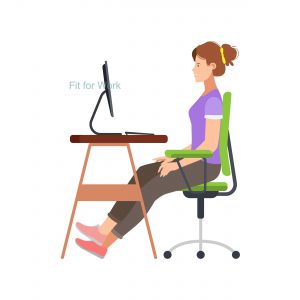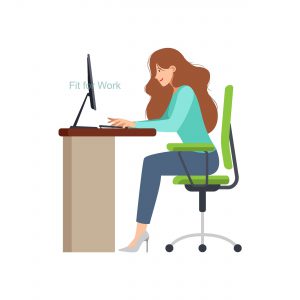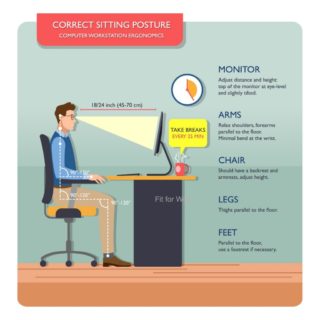Table of Contents

Sitting is something we all do daily, often for long periods. Therefore, examining the way in which we sit at our desk, and that we are sitting at our desk correctly, is of huge importance. Consider the different spaces you sit at throughout a day; your desk, commuting to work, at home watching TV, in a meeting room or when you are having lunch. Do you always consider your posture? Is your sitting posture always the same? Probably not! Discussions about the consequences of prolonged sitting are not new and have been a talking point for some time. Our bodies are not designed to stay in any one posture for prolonged periods.
WHY IS POSTURE IMPORTANT?
Posture is the way in which the body is held. Today, we will discuss posture in sitting, and sitting at your desk correctly.
The main aims of good sitting posture are:
-
-
- To keep the bones and joints in the correct alignment
- Prevent joints from becoming fixed in abnormal resting positions
- To prevent fatigue by using muscles more efficiently
- To prevent strain and overuse of joints, ligaments, and muscles
- Contribute to good appearance
- The prevention of pain
-
TIPS TO IMPROVE YOUR SITTING POSTURE
Feet – Should be comfortably placed flat on the floor or on a solid, stable surface. If your feet cannot reach the floor use a shorter chair or place a footrest underneath your feet.
Hips and Knees – Adjust your chair height to allow for a 90-degree bend at the knees. Your hips and knees should be somewhat parallel. Check that there is a small space between the back of your knees and the chair, this is to avoid pressure on the back of the knees. Avoid crossing your legs.

This person is sitting with their legs crossed under the desk, this may indicate that the desk and/or chair is not the correct height for the user.
Spine- Your spine requires support. Sit the whole way back into the chair and use the backrest. Keep your back in contact with the backrest at all times. If your chair has lumbar support, it needs to be at the level of the curve in the lower back.

In this image, take note of the person leaning onto the table with their forearms. The are not using the backrest. This may lead to lower back, neck and shoulder discomfort over time.
Upper Body- Keep your shoulders relaxed and elbows close to the body when working at a desk. Aim to keep your elbows at approximately 90-degrees and your forearms parallel to the floor. From here, keep your hands just over your keypad.
Head & Eyes- Sit up straight and look straight ahead to prevent placing strain on the neck. Keep your ears over your shoulders.
SITTING AT YOUR DESK CORRECTLY AND YOUR ENVIRONMENT
Environmental setup and posture are directly linked. Poor posture is regularly a response to a poorly set up environment. Take this opportunity to look around your desk and make sure all the objects you use frequently are close by and easy to reach.
MOVE!
Now you know how to sit well! However, no matter how comfortable you are, it is important to move often. Listen to your body as unconsciously altering your position is often a sign of fatigue. Every 30 -45 minutes stand up and move around briefly.
Overall, give yourself time to become aware of your sitting posture and commit to improving and maintaining good alignment. Remind yourself regularly to check you are sitting at your desk correctly and adjust as necessary.

ERGONOMICS SUPPORT FOR YOUR COMPANY
Fit For Work provide a range of ergonomics services which are suitable for those working from home/remotely or those who are office based. To learn more about office setup and good ergonomics principles, you can reach out to Fit for Work at info@fitforworksg.com to talk about how an ergonomic programme within your office can increase productivity, increase staff satisfaction, improve staff retention and reduce sick leave
Fit For Work provides ergonomics services which meet the specific and individualised needs of our clients globally. Our global team comprises of a network of accredited Ergonomists; many of whom with healthcare backgrounds in Occupational Therapy and Physiotherapy. Alongside consultant led ergonomics evaluations, talks and workshops, we provide interactive online tools to promote ergonomics awareness and assessment of the users workstation. Our online self-assessment tool and educational resource is ideal for companies with staff from multiple locations whether that is at home or in an office. Our mission is to engage people in a conversation about how to improve the quality of their working life, educate on what ergonomics can do for them and elevate their working experience.
This article does not constitute legal advice.
The opinions expressed in the column above represent the author’s own.
Start managing your legal needs with Zegal today
BECOME A ZEGAL REFERRAL PARTNER
READ MORE:5 Tips to stay sane and healthy when working from home
FURTHER READING: 4 Trends Shaping Online Businesses
Article syndicated with permission from https://www.fitforworksg.com/are-you-sitting-at-your-desk-correctly/
Fitforwork is a business in Singapore that focuses on the comfort of its clients. They use two most commonly used phrases; “Prevention is key and ‘” One size DOES NOT fit all. They believe that we are all different shapes and sizes, we have different work roles and demands, no two personal and professional situations are the same, therefore every workstation setup is unique to the individual and we must fit the work to the worker.
Their objective is to understand physical capabilities and work demands to reduce risk within the workplace, increase productivity and overall comfort and worker satisfaction. Their mission is to tell as many people as possible that the commonly felt neck pain, shoulder pain, back pain frequently experienced by office workers is not normal and that very some small changes can have a huge impact in reducing or eliminating these pains entirely.





